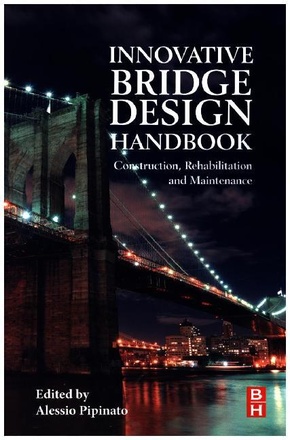Innovative Bridge Design Handbook - Construction, Rehabilitation and Maintenance
| Verlag | Butterworth-Heinemann |
| Auflage | 2016 |
| Seiten | 878 |
| Format | 15,4 x 4,1 x 22,9 cm |
| Gewicht | 1374 g |
| Artikeltyp | Englisches Buch |
| ISBN-10 | 0128000589 |
| EAN | 9780128000588 |
| Bestell-Nr | 12800058EA |
As known, each bridge presents a unique set of design, construction, and maintenance challenges. The designer must determine the appropriate methods and level of refinement necessary to design and analyze each bridge on a case-by-case basis. The Innovative Bridge Design Handbook: Construction, Rehabilitation, and Maintenance encompasses the state of the art in bridge design, construction, maintenance, and safety assessment. Written by an international group of experts, this book provides innovative design approaches used in various parts of the world and explores concepts in design, construction, and maintenance that will reduce project costs and increase structural safety and durability. Furthermore, research and innovative solutions are described throughout chapters.
The Innovative Bridge Design Handbook: Construction, Rehabilitation, and Maintenance brings together the specific knowledge of a bevy of experts and academics in bridge engineering in the areas of desi gn, assessment, research, and construction. The handbook begins with an analysis of the history and development of bridge aesthetics and design; various types of loads including seismic and wind loads are then described, together with fatigue and fracture. Bridge design based on material such as reinforced concrete, prestressed reinforced concrete, steel and composite, timber, masonry bridges is analyzed and detailed according to international codes and standards. Then bridge design based on geometry, such as arch bridges, girders, cable stayed and suspension bridges, is illustrated. This is followed by a discussion of a number of special topics, including integral, movable, highway and railway bridges, together with seismic component devices, cables, orthotropic decks, foundations, and case studies. Finally, bridge construction equipment, bridge assessment retrofit and management, bridge monitoring, fiber-reinforced polymers to reinforce bridges, bridge collapse issues are covere d.
Inhaltsverzeichnis:
Section I Fundamentals
Chapter1 The history, aesthetics, and design of bridges
Section II Loads on bridges
Chapter 2 Loads on bridges
Chapter 3 Wind loads
Chapter 4 Fatigue and fracture
Section III Structural analysis
Chapter 5 Bridge structural theory and modeling
Chapter 6 Dynamics of bridge structures
Chapter 7 Risk and reliability in bridges
Chapter 8 Innovative structural typologies
Section IV Bridge design based on construction material type
Chapter 9 Reinforced and prestressed concrete bridges
Chapter 10 Steel and composite bridges
Chapter 11 Timber bridges
Chapter 12 Masonry bridges
Section V Bridge design based on geometry
Chapter 13 Arch bridges
Chapter 14 Girders
Chapter 15 Long-span bridges
Section VI Special topics
Chapter 16 Integral bridges
Chapter 17 Movable bridges
Chapter 18 Hig hway bridges
Chapter 19 Railway bridges
Section VII Bridge components
Chapter 20 Seismic component devices
Chapter 21 Cables
Chapter 22 Orthotropic steel decks
Chapter 23 Bridge foundations
Section VIII Bridge construction
Chapter 24 Case study: the Reno bridge
Chapter 25 Case study: the Russky bridge
Chapter 26 Case study: the Akashi-Kaikyo bridge
Chapter 27 Bridge construction equipment
Section IX: Assessment, managment, retrofit, monitoring and rehabilitation of existing bridges
Chapter 28 Bridge assessment, retrofit, and management
Chapter 29 Bridge monitoring
Chapter 30 Application of fiber-reinforced polymers to reinforced concrete bridges
Chapter 31 Bridge collapse

